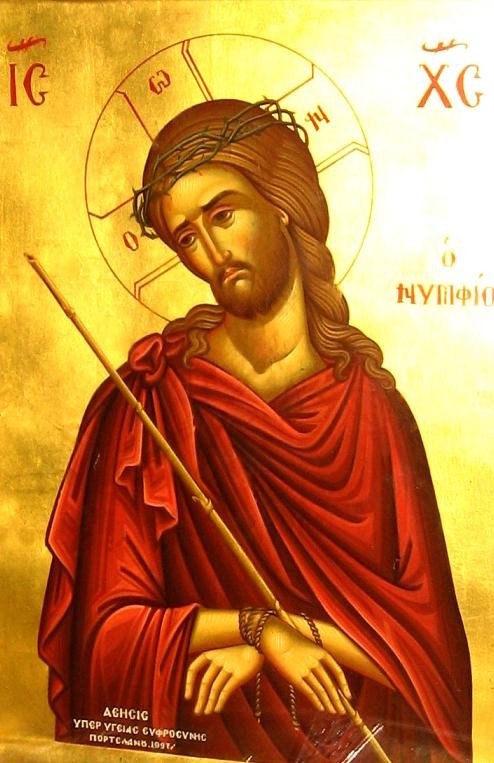Icon Project Update: Jesus “the Bridegroom”
Here is the most-recently completed icon by Oleksiy Mezentsev of Jesus Christ as the Bridegroom (an icon that is used during Great Lent featuring Jesus with the crown of thorns on His head), which was blessed into use on Sunday Aug. 13, 2023.
Read about the icon project. We are looking to start the next icon soon so if you are interested in donating an icon in the memory of a family-member, please contact either of our parish priests or the parish office.
About the Icon
As excerpted from A Reader’s Guide to Orthodox Icons.During the first service on Palm Sunday evening, the priest carries an icon of Christ the Bridegroom to the front of the church, where it remains until Holy Thursday. The three days of Holy Week it is there are dedicated to Jesus Christ as the central figure in the parable of the Ten Virgins (Matthew 25: 1-13). This parable is perfect for the week leading up to Easter, as its clear message is to be prepared for the coming of Christ. From the evening service mentioned:
Behold, the Bridegroom comes in the middle of the night,
And blessed is the servant He shall find vigilant;
But unworthy is he whom he shall find neglectful.
Beware therefore, O my soul, lest you be weighed down by sleep,
Lest you be given over to death and be closed out from the kingdom;
But rise up crying out: “Holy! Holy! Holy are You our God;
Through the intercessions of the Theotokos, have mercy on us.”
(Troparion of the Bridegroom Service)
Icon in the Church of the Holy Sepulcher, Jerusalem. adriatikus, CC BY-SA 3.0, via Wikimedia Commons
Given the eschatological undertones of the services (“Christ is coming: look busy!”) it might be expected for the Bridegroom icon to show Christ in Glory, or at His Second Coming. Yet the Icon shows Christ humiliated by Pontius Pilate’s soldiers (Matthew 27:27-31). In a cruel irony, the soldiers mockingly worshiped Jesus and through insults proclaimed Him rightly to be the King of the Jews. Crowned with thorns, cloaked in scarlet, bound and holding a reed, this is how Christ appears in the Bridegroom Icon.
The crown is a symbol of Christian marriage in the Orthodox Church, and the ropes binding Christ’s hand are a near-universal symbol of marriage. The reed used as a mock-scepter is a symbol of humility, of a person that does all possible to bend in service to others.
In stark contrast to the fearsome images of Christ the King presented at the beginning of Lent, we are now presented with our suffering Bridegroom. Why does He suffer? Because of human sin. The betrayal of Judas, the hatred of the Jews, the cowardice of Pilate, the cruelty of the Romans: this is why Christ appears as He does. What form of humanity is not represented by those who mocked Jesus?
Yet still He stands before us. While we are still as unfaithful as harlots, Christ is betrothed to us. This is Divine Love, that while we were still sinners, Christ died for us . Such perfect, divine, love casts out all fear; and so instead of the stern Judge of the Apocalypse to spur us to repentance, we “behold the man”: the Bridegroom Who burns with such love for us that He suffers death on the Cross.
This Icon, this image of the Bridegroom, shows us nothing more than what the Roman soldiers who spat upon Christ saw. It is up to us whether we see beyond the bloody, brutalised, Jew before us and recognize our divine spouse. A good sign we have benefited from the rigours of Lent is when we look upon our humiliated King and still worship Him. Ah…but, no, even the Roman soldiers did that. With hard-hearts they hailed Him as king, bowed down before him, then led Him off to be executed. Our worship, our repentance, must be longer-lasting.
I see Thy Bridal Chamber adorned, O my Savior, but have no wedding garment that I may enter. O Giver of Light, enlighten the vesture of my soul, and save me!


